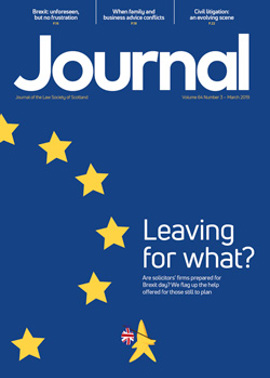Moving nightmares

There is an old adage that moving home is one of the most stressful things people encounter in life; and that’s just for the home-movers! The ever competitive Scottish conveyancing market has put pressure on practising solicitors to do more work in less time, with the knock-on effect that mistakes will, on occasion, be made.
The sharp uptick in lender claims following the financial crisis might be levelling off, particularly since the Supreme Court’s decision in Gordon’s Trustees cast further doubt on the right to bring claims arising from historic transactions. However, following the initial drop-off in residential sales in 2008-09, the Scottish housing market seems to have been making a steady recovery, with a little over 100,000 transactions recorded in 2017. With such a significant number of transactions involving high-value assets, it is perhaps unsurprising that conveyancing continues to be one of the main breeding grounds for professional negligence claims against solicitors.
Claims most commonly arise where there has been an error in delivering the most fundamental elements to a good and marketable title: first, that the sellers are able to transfer sufficient rights to afford ownership and enjoyment of the property; and secondly, that the property has adequate access rights and is not unduly encumbered by any rights held by third parties. It follows that property lawyers regularly face claims which are predominantly about the extent of a property or the related access rights. This article will focus on these two problem areas and suggest some general risk management tools which can often be adopted to help avoid similar errors being made.
Boundary issues: where to draw the line?
Any disconnect between what the purchaser thinks they are buying and what is actually transferred most often arises following split-off transactions, where a sliver of land is omitted from the new title plan or a boundary is not accurately drawn. All too often, land which is virtually worthless, in itself, then has its significance blown out of all proportion during vitriolic neighbour disputes. Sometimes that small portion of land is crucial to the enjoyment of the property, for example where it runs across a driveway, thus making it technically impossible to access the property’s garage with a vehicle. In other cases, whole parcels of land or buildings are claimed to have been unexpectedly omitted from a purchaser’s title – and inevitably, in the context of a claim, these are said to have been key to the decision to purchase in the first place.
Where there is an issue relating to the extent of a property, one might expect that a solicitor would simply apportion blame to a surveyor. This can often be strenuously resisted, however, on the basis of case law which suggests that where such “information” has been provided (as opposed to advice), any responsibility on the surveyor’s part should be limited to a resulting difference in value in the property; or worse, that the purchasing solicitor had an overriding duty to check the extent of title as shown in the surveyor’s plan and spot any issues. The reality is that wherever a purchaser’s expectations as to the extent of a property are not met, a claim against the solicitor often follows.
Access all areas
Being able to access a property is clearly key to its enjoyment. If a purchaser does become embroiled in an access dispute, he or she will inevitably complain that the solicitor has failed to advise on sufficiency of the access rights or the existence of any third party rights over the land. A purchaser might claim that he or she simply didn’t know the precise nature and extent of the access rights; that an access strip was the wrong width; or that it didn’t allow for the right kind of traffic. They might say they didn’t know who was responsible for the maintenance of any access routes or they didn’t have explicit rights that would allow them to carry out any upkeep. Some claims arise because a property doesn’t have suitable provision for utilities.
Another familiar access-related problem arises when the purchaser intends to put the property to some previously unanticipated use: a farm is to be developed to include a farm shop or converted into housing, or a residential dwelling is to be used to run a small business. If a servitude is too specific it may defeat such a change of use, and then questions will be asked about whether the solicitor knew or ought to have asked about their client’s intentions. Too often solicitors have to admit that they had no knowledge of their client’s motives for purchasing a property, without having taken the simple step of asking.
Often claims relating to access issues will boil down to whether the solicitor adequately explained:
- the nature and extent of the available access rights to, or over, a property;
- any opportunities for negotiating those during the course of a transaction;
- the nature and extent of any risks associated with the access rights; or
- whether there were any steps that might be taken in mitigation, including whether title indemnity insurance might assist and, importantly – an issue not properly understood by many solicitors – the degree of protection that might be provided by such a policy.
Stop and think
Surprisingly few claims against solicitors in Scotland arise from errors in law, however. Rarely do we see a conveyancing solicitor misinterpret a relevant provision in the title or what it might mean for their client. More often than not, an issue arises because the provision has not been considered in sufficient detail, the client’s understanding of the issues or their instructions weren’t clear, or a point of detail is simply missed.
It follows that additional legal training is not necessarily the answer to avoiding these claims. The reality is far more mundane: solicitors need to take the time to stop and think about each transaction. This is, of course, much easier to say than to do, given the constant pressure to complete more work in less time. However, there are steps which can be taken to insulate oneself from claims.
When it comes to checking extent, happily most conveyancers do routinely send their clients a colour copy of the title plan and record on the file that they have confirmed that the plan accords with what they think they are buying/selling (and if you don’t already, you should start, immediately!). In more complex transactions this may not be enough, and taking the time to examine the plan along with the client is a worthwhile check. While you will probably not have visited the property, and in most cases would not be under any duty to do so, you may be able to recognise potential issues from the plan and specifically highlight them to the client.
Pausing to ask what the purchaser intends to do with the property should then open the door to a discussion on the nature and extent of the access rights, and whether those match up to their expectations and intentions. That should also alert a conveyancer to whether any third party access rights might interfere with the purchaser’s enjoyment.
In all but the most simple of transactions, a second pair of eyes is an excellent way to spot dangers or at least demonstrate that reasonable steps have been taken to try and identify those. A formal internal review and supervision procedure should be as much a part of the routine as a letter of engagement or completion statement. Of course, commercial pressures don’t always allow for spending additional time, so systems and procedures are crucial to ensuring that key issues have been considered and advised upon. Developing a comprehensive checklist is a great start; and adhering to it will usually become second nature in time.
Put it in writing
For the professional negligence lawyer, there is nothing more frustrating than acting for an adviser who gave all the right advice, but did not record it in writing. Several years down the line, when the former client has no recollection of the wonderfully detailed and appropriate wisdom imparted to them by their adviser, they will all too often simply deny it ever happened. Without a file note or correspondence to point to, the very real risk is that the former client may be believed. It is often said that clients are only involved in a small number of transactions compared with their advisers, and therefore the client’s recollection of the specific discussions should be preferred over the adviser who performs such tasks day in, day out. It’s difficult to dispute that the adviser could have deviated from their “ordinary practice” on at least one occasion.
Traditional notes on title have fallen out of favour, at least in those transactions where claims have arisen. That was probably inevitable following land registration, but from a practical perspective, the risk of a claim can still be reduced by keeping a good file. It follows that any advice given to a client must be recorded in writing, as should their response to any requests for information. This includes recording that the client has checked the extent of the title plan and the sufficiency of the access rights for their purposes (and indeed your explanation of what those access rights amount to).
Reducing the risk
Although boundary and access issues are the specific focus of this article, the precautions suggested above can help to minimise the risk of claims across all practice areas and professions. At the very least, properly documenting such steps could provide some basis for a defence if the worst does happen.
The lesson for conveyancing practitioners is the same for all professional advisers: develop a robust process and stick to it; get into the habit of preparing full attendance notes as soon as important conversations happen (documenting the nature of any advice, requests for information and any client responses); and confirm all advice in a letter or email to the client.
In this issue
- How will Brexit affect my mother-in-law?
- Settling the debate on sequestration
- Taking wellbeing seriously
- How will personal data continue to flow after Brexit?
- Buildmark, and a little extra help for NHBC
- Reading for pleasure
- Opinion: Laurie Anderson
- Book reviews
- Profile: Lord Mackay of Clashfern
- President's column
- People on the move
- Is your legal software ready to remain compliant in 2019?
- What's the deal?
- Ready to leave?
- A tapering opportunity
- Brexit: no dealbreaker either
- The business of divorce
- Trailblazing 12
- Cohabitants: rebalancing the law
- Litigation: an evolving scene
- Chain transactions
- When delay is not fatal
- Data protection – deal or no-deal?
- Two cases and an order
- Reshaping trade mark law
- When the wheels come off
- Parentage or privacy?
- Access right, right of access or right of way?
- Team of one
- Public policy highlights
- OPG update
- Housing specialism added to accreditation list
- At the boundary's edge
- Keep the dual role
- Executry and trust accounting: new guidance
- Moving nightmares
- Accredited paralegal update
- Sign up for conference
- Accredited Paralegal Committee profile
- Ask Ash






